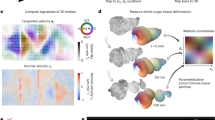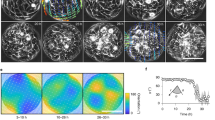Abstract
The dynamic reshaping of tissues during morphogenesis results from a combination of individual cell behaviors and collective cell rearrangements. However, a comprehensive framework to unambiguously measure and link cell behavior to tissue morphogenesis is lacking. Here we introduce such a kinematic framework, bridging cell and tissue behaviors at an intermediate, mesoscopic, level of cell clusters or domains. By measuring domain deformation in terms of the relative motion of cell positions and the evolution of their shapes, we characterized the basic invariant quantities that measure fundamental classes of cell behavior, namely tensorial rates of cell shape change and cell intercalation. In doing so we introduce an explicit definition of cell intercalation as a continuous process. We mapped strain rates spatiotemporally in three models of tissue morphogenesis, gaining insight into morphogenetic mechanisms. Our quantitative approach has broad relevance for the precise characterization and comparison of morphogenetic phenotypes.
This is a preview of subscription content, access via your institution
Access options
Subscribe to this journal
Receive 12 print issues and online access
$259.00 per year
only $21.58 per issue
Buy this article
- Purchase on Springer Link
- Instant access to full article PDF
Prices may be subject to local taxes which are calculated during checkout





Similar content being viewed by others
References
Keller, R. et al. Mechanisms of convergence and extension by cell intercalation. Phil. Trans. Roy. Soc. B 355, 897–922 (2000).
Bertet, C., Sulak, L. & Lecuit, T. Myosin-dependent junction remodelling controls planar cell intercalation and axis elongation. Nature 429, 667–671 (2004).
Concha, M.L. & Adams, R.J. Oriented cell divisions and cellular morphogenesis in the zebrafish gastrula and neurula: a time-lapse analysis. Development 125, 983–994 (1998).
Neumann, M. & Affolter, M. Remodelling epithelial tubes through cell rearrangements: from cells to molecules. EMBO Rep. 7, 36–40 (2006).
Hutson, M.S. et al. Forces for morphogenesis investigated with laser microsurgery and quantitative modelling. Science 300, 145–149 (2003).
Moore, S.W., Keller, R.E. & Koehl, M.A.R. The dorsal involuting marginal zone stiffens anisotropically during its convergent extension in the gastrula of Xenopus laevis. Development 121, 3131–3140 (1995).
Keller, R., Shook, D. & Skogland, P. The forces that shape embryos: physical aspects of convergent extension by cell intercalation. Phys. Biol. 5, 15007 (2008).
England, S.J., Blanchard, G.B., Mahadevan, L. & Adams, R.J. A dynamic fate map of the forebrain shows how vertebrate eyes form and explains two causes of cyclopia. Development 133, 4613–4617 (2006).
Keller, P.J., Schmidt, A.D., Wittbrodt, J. & Stelzer, E.H.K. Reconstruction of zebrafish early embryonic development by scanned light sheet microscopy. Science 322, 1065–1069 (2008).
Graner, F., Dollet, B., Raufaste, C. & Marmottant, P. Discrete rearranging disordered patterns, part I: Robust statistical tools in two or three dimensions. Eur. Phys. J. E 25, 349–369 (2008).
Fung, Y.C. & Tong, P. Classical and Computational Solid Mechanics (World Scientific, Singapore, 2001).
Glickman, N.S., Kimmel, C.B., Jones, M.A. & Adams, R.J. Shaping the zebrafish notochord. Development 130, 873–887 (2003).
Yin, C. et al. Cooperation of polarized cell intercalations drives convergence and extension of presomitic mesoderm during zebrafish gastrulation. J. Cell Biol. 180, 221–232 (2008).
Weaire, D. & Hutzler, S. The Physics of Foams (Oxford University Press, Oxford, 2001).
Farhadifar, R. et al. The influence of cell mechanics, cell-cell interactions, and proliferation on epithelial packing. Curr. Biol. 17, 2095–2104 (2007).
Hilgenfeldt, S., Erisken, S. & Carthew, R.W. Physical modeling of cell geometric order in an epithelial tissue. Proc. Natl. Acad. Sci. USA 105, 907–911 (2008).
Jacinto, A., Woolner, S. & Martin, P. Dynamic analysis of dorsal closure in Drosophila: from genetics to cell biology. Dev. Cell 3, 9–19 (2002).
Kiehart, D.P. et al. Multiple forces contribute to cell sheet morphogenesis for dorsal closure in Drosophila. J. Cell Biol. 149, 471–490 (2000).
Fernandez, B.G., Arias, A.M. & Jacinto, A. Dpp signalling orchestrates dorsal closure by regulating cell shape changes both in the amnioserosa and in the epidermis. Mech. Dev. 124, 884–897 (2007).
Irvine, K.D. & Weischaus, E. Cell intercalation during Drosophila germband extension and its regulation by pair-rule segmentation genes. Development 120, 827–841 (1994).
Blankenship, J.T. et al. Multicellular rosette formation links planar cell polarity to tissue morphogenesis. Dev. Cell 11, 459–470 (2006).
Butler, L.C. et al. Cell shape changes indicate a role for extrinsic tensile forces in Drosophila germband extension. Nat. Cell Biol. (in the press).
Keller, R., Shih, J. & Sater, A. The cellular basis of the convergence and extension of the Xenopus neural plate. Dev. Dyn. 193, 199–217 (1992).
Hong, E. & Brewster, R. N-cadherin is required for the polarized cell behaviors that drive neurulation in the zebrafish. Development 133, 3895–3905 (2006).
Pope, K.L. & Harris, T.J. Control of cell flattening and junctional remodelling during squamous epithelial morphogenesis in Drosophila. Development 135, 2227–2238 (2008).
Gorfinkiel, N., Blanchard, G.B., Adams, R.J. & Arias, A.M. Mechanical control of global cell behaviour during dorsal closure in Drosophila. Development (in the press).
Allmendinger, R.W., Relinger, R. & Loveless, J. Strain and rotation rate from GPS in Tibet, Anatolia, and the Altiplano. Tectonics 26, TC3013 (2007).
Press, W.H., Flannery, B.P., Teukolsky, S.A. & Vetterling, W.T. Numerical Recipes in C (Cambridge University Press, Cambridge, UK, 1988).
Aubouy, M., Jiang, Y., Glazier, J.A. & Graner, F. A texture tensor to quantify deformations. Granular Matter 5, 67–70 (2003).
Draper, N.R. & Smith, H. Applied Regression Analysis 3rd edition (John Wiley & Sons Inc., New York, 1998).
Oda, H. & Tsukita, S. Real-time imaging of cell-cell adherens junctions reveals that Drosophila mesoderm invagination begins with two phases of apical constriction of cells. J. Cell Sci. 114, 493–501 (2001).
Campos-Ortega, J.-A. & Hartenstein, V. The Embryonic Development of Drosophila melanogaster (Springer-Verlag, Berlin, 1997).
Acknowledgements
We acknowledge financial support from the Medical Research Council (R.J.A.) and the Harvard Materials Research Science and Engineering Center (L.M.). Additional financial support was from a Wellcome Trust studentship to N.L.S. (zebrafish trunk studies); a Human Frontier Science Program grant to B.S. and a Wellcome Trust studentship to L.C.B. (Drosophila germband extension studies); and a Biotechnology and Biological Sciences Research Council grant to Alfonso Martinez Arias and N.G. (Drosophila dorsal closure studies). We thank N.J. Lawrence, who initiated Drosophila germband extension imaging, S.J. England and S.R. Young for fruitful discussions. This paper is dedicated to the memory of Locke G. Nolan Blanchard.
Author information
Authors and Affiliations
Contributions
G.B.B., A.J.K., L.M. and R.J.A. conceived and developed the project and wrote the manuscript. G.B.B. and A.J.K. analyzed data and developed the code. N.L.S. (zebrafish trunk), L.C.B., B.S. (Drosophila germband extension) and N.G. (Drosophila dorsal closure) all collaborated to develop the analyses and contributed time-lapse movies and expertise on their models.
Corresponding authors
Supplementary information
Supplementary Text and Figures
Supplementary Figures 1–4, Supplementary Note (PDF 974 kb)
Supplementary Software
Zip file of code written in IDL for calculating strain rates in a domain of tissue. (ZIP 8 kb)
Supplementary Video 1
Tracked cell trajectories and membrane shapes in Drosophila amnioserosa. Video to accompany Figure 4a. Video duration is 50 min, with frames at 2 min intervals. Details are as in Figure 4. (MOV 198 kb)
Supplementary Video 2
Tracked cell trajectories and membrane shapes in Drosophila germband. Video to accompany Figure 4i. Video duration is 15 mins, with frames at 30s intervals. Details are as in Figure 4. (MOV 576 kb)
Supplementary Video 3
Tracked cell trajectories and membrane shapes in zebrafish trunk ectoderm. Video to accompany Figure 4q. Video duration is 50 mins, with frames at 2 min intervals. Details are as in Figure 4. (MOV 590 kb)
Supplementary Video 4
Cellular simulation of a domain dominated by cell shape change. Video to accompany Figure 2a simulation. Video duration is 50 mins, with frames every minute. (MOV 38 kb)
Supplementary Video 5
Cellular simulation of a domain dominated by cell intercalation. Video to accompany Figure 2b simulation. Video duration is 50 mins, with frames every minute. (MOV 37 kb)
Supplementary Video 6
Tissue deformations and rotations in Drosophila amnioserosa. Video to accompany Figure 4c. Video duration is 50 mins, with frames at 2 min intervals. Details are as in Figure 4. (MOV 114 kb)
Supplementary Video 7
Cell shape deformations in Drosophila amnioserosa. Video to accompany Figure 4e. Video duration is 50 mins, with frames at 2 min intervals. Details are as in Figure 4. (MOV 110 kb)
Supplementary Video 8
Cell intercalation deformations in Drosophila amnioserosa. Video to accompany Figure 4g. Video duration is 50 mins, with frames at 2 min intervals. Details are as in Figure 4. (MOV 45 kb)
Supplementary Video 9
Tissue deformations and rotations in Drosophila germband. Video to accompany Figure 4k. Video duration is 15 mins, with frames at 30s intervals. Details are as in Figure 4. (MOV 425 kb)
Supplementary Video 10
Cell shape deformations in Drosophila germband. Video to accompany Figure 4m. Video duration is 15 mins, with frames at 30s intervals. Details are as in Figure 4. (MOV 313 kb)
Supplementary Video 11
Cell intercalation deformations in Drosophila germband. Video to accompany Figure 4o. Video duration is 15 mins, with frames at 30s intervals. Details are as in Figure 4. (MOV 325 kb)
Supplementary Video 12
Tissue deformations and rotations in zebrafish trunk ectoderm. Video to accompany Figure 4s. Video duration is 50 mins, with frames at 2 min intervals. Details are as in Figure 4. (MOV 297 kb)
Supplementary Video 13
Cell shape deformations in zebrafish trunk ectoderm. Video to accompany Figure 4u. Video duration is 50 mins, with frames at 2 min intervals. Details are as in Figure 4. (MOV 231 kb)
Supplementary Video 14
Cell intercalation deformations in zebrafish trunk ectoderm. Video to accompany Figure 4w. Video duration is 50 mins, with frames at 2 min intervals. Details are as in Figure 4. (MOV 232 kb)
Rights and permissions
About this article
Cite this article
Blanchard, G., Kabla, A., Schultz, N. et al. Tissue tectonics: morphogenetic strain rates, cell shape change and intercalation. Nat Methods 6, 458–464 (2009). https://doi.org/10.1038/nmeth.1327
Received:
Accepted:
Published:
Issue Date:
DOI: https://doi.org/10.1038/nmeth.1327
This article is cited by
-
Adherens junctions as molecular regulators of emergent tissue mechanics
Nature Reviews Molecular Cell Biology (2023)
-
Active cell divisions generate fourfold orientationally ordered phase in living tissue
Nature Physics (2023)
-
TubULAR: tracking in toto deformations of dynamic tissues via constrained maps
Nature Methods (2023)
-
Patterned mechanical feedback establishes a global myosin gradient
Nature Communications (2022)
-
Embryo-scale epithelial buckling forms a propagating furrow that initiates gastrulation
Nature Communications (2022)



